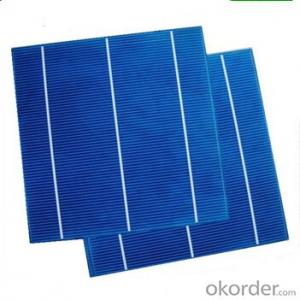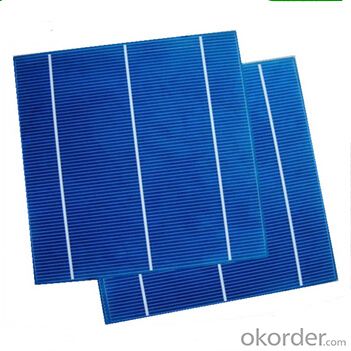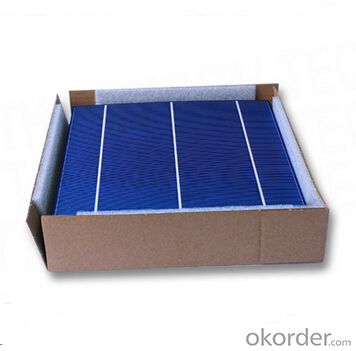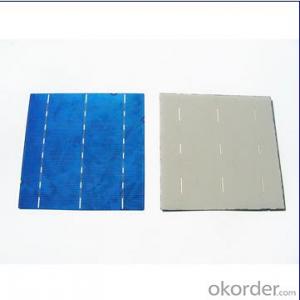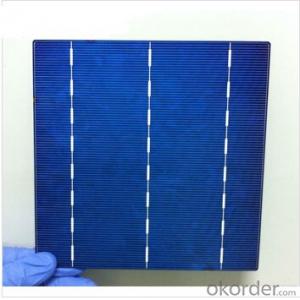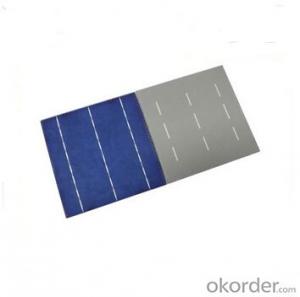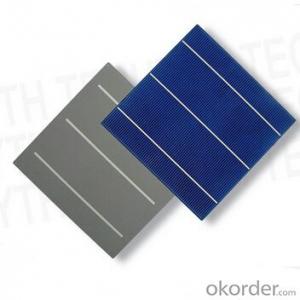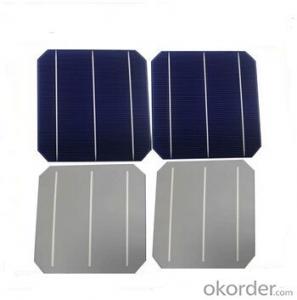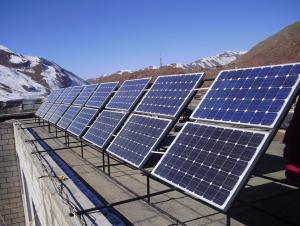Rotating Polycrystalline Solar Cells Series - 16.00%-18.20%
- Loading Port:
- Shanghai
- Payment Terms:
- TT OR LC
- Min Order Qty:
- 3000 pc
- Supply Capability:
- 300000 pc/month
OKorder Service Pledge
OKorder Financial Service
You Might Also Like
Solar Cells:
Solar cells is made by solar wafer, it has three categories of solar cell right now, monocrystalline polycrystalline and thin film,These cells are entirely based around the concept PN junction, which is the critical part of solar module, it is the part that can convert the light energy into electricity, the thickness is from 180um to 200um, with even busbars to conduct electricity, textured cell can decrease diffuse reflection; they are often electrically connected and encapsulated as a module. Photovoltaic modules often have a sheet of glass on the front (sun up) side, allowing light to pass while protecting semiconductor wafers from abrasion and impact due to wind-driven debris, rain, hail, etc. Solar cells are also usually connected in series in modules, creating an additive voltage. Connecting cells in parallel will yield a higher current;With high quality and stable quality. Our Cells can greatly improve the performance of Solar Modules.
Features:
1. High conversion efficiencies resulting in superior power output performance.
2. Proven long term mechanical stability of silicon
3. Make of highly purified poly silicon
4. Three bus bars for reduced series resistance and improved module and cell efficiency
5. Blue anti-reflecting coating ensures improved light absorption and increased efficiency
6. Acid texturization offers a uniform appearance and virtually invisible crystal structure
7. Excellent low light behavior for improved energy yield
Solar Cells Advantage:
1. Tire-1 Solar Cells’ Manufacturer Quality Guarantee. With a complete and sophisticated quality government system, our Quality Management have arrived world’s leading place. Customer can receive Tire-1 Cells Maker’s Quality Standard Products.
2. Trusted Warranty. We can supply trusted after-sales service to our customer. If our cells are found not in conformity to the specification of manufacturer, or should the inspected quantity found in shortage, or should the packing found damaged, the buyer has the right to claim to the seller. The claim, if any, should be presented to seller within 30 days after cargo's arrival date to the port, together with related inspection report and photos issued and provided by a reputable independent surveyor such as SGS.
3. World’s Leading Manufacturer Equipment. We imported the newest and leading production equipment from abroad. Advanced equipment can guarantee the stable quality of cells. Auto production line can also save labor cost which will further cut our production cost.
4. Bulk supply: With the production capacity of 500MW, we can produce large quantity every month. This can satisfy most customer requirement.
Specifications:
Mechanical Data and Design | Intensity Dependence | |||||||||
Cells | Poly6"(R220) crystal | Intensity[W/m2] | Isc *[mA] | Voc*[mV] | ||||||
Format | 156mm*156mm±0.5mm | 1000 | 1 | 1 | ||||||
Thickness | 190um±20um | 900 | 0.9 | 0.994 | ||||||
Front(-) | 1.4mm bus bars (silver), | 500 | 0.5 | 0.969 | ||||||
blueanti-reflectingcoating (silicon nitride) | 300 | 0.3 | 0.946 | |||||||
Back(+) | 3mm wide soldering pads (silver) | 200 | 0.2 | 0.926 | ||||||
Back surface field (aluminium) | ||||||||||
Electrical typical values | ||||||||||
Product model | Eff. % | Pmax (W) | Vpm(V) | Ipm (A) | Voc(V) | Isc(A) | ||||
18.20%-4.429W | EFF≥18.20% | Pmax ≥4.429 | 0.535±3 | 8.2785 | 0.636 | 8.815 | ||||
18.00%-4.380W | 18.20%>EFF≥18.00% | 4.429>Pmax ≥4.380 | 0.534±3 | 8.2022 | 0.635 | 8.753 | ||||
17.80%-4.332W | 18.00%>EFF≥17.80% | 4.380>Pmax ≥4.332 | 0.533±3 | 8.1088 | 0.634 | 8.704 | ||||
17.60%-4.283W | 17.80%>EFF≥17.60% | 4.332>Pmax ≥4.283 | 0.531±3 | 8.0662 | 0.633 | 8.620 | ||||
17.40%-4.234W | 17.60%>EFF≥17.40% | 4.283>Pmax ≥4.234 | 0.530±3 | 7.9896 | 0.632 | 8.610 | ||||
17.20%-4.186W | 17.40%>EFF≥17.20% | 4.234>Pmax ≥4.186 | 0.529±3 | 7.9127 | 0.631 | 8.529 | ||||
17.00%-4.137W | 17.20%>EFF≥17.00% | 4.186>Pmax ≥4.137 | 0.527±3 | 7.8503 | 0.630 | 8.459 | ||||
16.80%-4.088W | 17.00%>EFF≥16.80% | 4.137>Pmax ≥4.088 | 0.524±3 | 7.8024 | 0.629 | 8.397 | ||||
16.60%-4.040W | 16.80%>EFF≥16.60% | 4.088>Pmax ≥4.040 | 0.521±3 | 7.7539 | 0.627 | 8.239 | ||||
16.40%-3.991W | 16.60%>EFF≥16.40% | 4.040>Pmax ≥3.991 | 0.519±3 | 7.6900 | 0.625 | 8.198 | ||||
16.20%-3.942W | 16.40%>EFF≥16.20% | 3.991>Pmax ≥3.942 | 0.516±3 | 7.6404 | 0.623 | 8.153 | ||||
16.00%-3.894W | 16.20%>EFF≥16.00% | 3.942>Pmax ≥3.894 | 0.514±3 | 7.5754 | 0.620 | 8.145 | ||||
Temperature Coefficients | TkVoltage | -0.348%/K | ||||||||
TkCurrent | +0.031%/K | |||||||||
TkPower | -0.46%/K | |||||||||
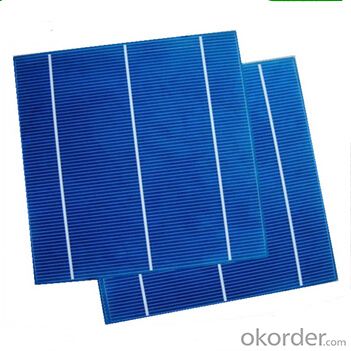
FAQ
We have organized several common questions for our clients,may help you sincerely:
①What price for each watt?
It depends on the efficiency of the solar cell, quantity, delivery date and payment terms.
②How long can we receive the product after purchase?
In the purchase of product within three working days, We will arrange the factory delivery as soon as possible. The pecific time of receiving is related to the state and position of customers.Commonly 7 to 10 working days can be served.
③Can you provide the peripheral products of the solar panels, such as the battery, controller, and inverter? If so, can you tell me how do they match each other?
Yes, we can, we have two companies for solar region, one is CNBM International, the other is CNBM engineering Co.
We can provide you not only the solar module but also the off grid solar system, we can also provide you service with on grid plant.
④What is your warranty of solar cell?
Our product can promise lower than 0.3% open box crack, we support claim after opening the box if it has crackm color difference or sth, the buyer should give pictures immediately, we can not accept the claim after the solar cell has assembled to solar panel.
• Timeliness of delivery
• ⑤How do you pack your products?
We have rich experience on how to pack the solar cell to make sure the safety on shipment, we could use wooden box or pallet as buyer's preference.
- Q: Can solar cells be used for indoor applications?
- Yes, solar cells can be used for indoor applications. While solar cells are primarily designed to harness sunlight and convert it into electricity, they can also generate power from indoor lighting sources such as fluorescent or LED lights. However, the amount of electricity generated indoors is generally lower compared to outdoor conditions due to the reduced intensity of indoor lighting. Nonetheless, solar cells can still be used effectively for powering small devices or charging batteries in indoor settings.
- Q: What is the solar cell production process
- Scientists in order to reduce the cost of solar cell manufacturing, along the two paths: one is the development of new solar cell materials, the other path is to improve the efficiency of solar cell conversion.
- Q: How big are solar cells?
- Solar cells vary in size depending on their intended use and technology. Traditional silicon-based solar cells typically range in size from a few square centimeters to around 200 square centimeters. However, advancements in solar technology have led to the development of smaller, more efficient solar cells, known as thin-film solar cells, which can be as small as a few square millimeters. Additionally, solar cells can be grouped together to form larger arrays, which are commonly used in residential, commercial, and utility-scale solar installations.
- Q: Are solar cells affected by electromagnetic interference?
- Yes, solar cells can be affected by electromagnetic interference. Electromagnetic interference can degrade the performance of solar cells by disrupting the flow of electrons and causing fluctuations in output power. However, proper shielding and grounding techniques can be implemented to minimize these effects and ensure optimal functioning of solar cells.
- Q: What is the difference between solar cells and solar panels?
- Solar cells and solar panels are closely related but have some key differences. A solar cell refers to a single unit that converts sunlight into electricity through the photovoltaic effect. It is the basic building block of a solar panel. On the other hand, a solar panel, also known as a photovoltaic module, is made up of multiple interconnected solar cells. The purpose of a solar panel is to harness a larger amount of sunlight and generate a higher output of electricity. In summary, while a solar cell is the individual component that directly converts sunlight into electricity, a solar panel is a collection of interconnected solar cells that work together to produce a higher power output.
- Q: What is the impact of bird droppings on solar cell performance?
- Bird droppings have a negative impact on solar cell performance as they can obstruct sunlight and reduce the amount of energy produced by the cells. Additionally, the droppings can cause corrosion and damage to the surface of the cells, leading to further efficiency losses over time. Regular cleaning and maintenance are necessary to mitigate these effects and ensure optimal solar cell performance.
- Q: What is the role of voltage regulators in solar cell systems?
- The role of voltage regulators in solar cell systems is to ensure a stable and regulated output voltage from the solar panels. They act as a control mechanism to prevent overcharging of batteries or damage to electronic devices by regulating the incoming voltage from the solar cells. Voltage regulators also help optimize the efficiency of the solar cell system by matching the voltage levels of the solar panels with the load requirements, thereby maximizing the energy conversion and utilization.
- Q: Can solar cells be used in water pumps?
- Yes, solar cells can be used in water pumps. Solar-powered water pumps utilize solar panels to convert sunlight into electricity, which can power the pump. This enables the pumps to operate independently of grid electricity, making them ideal for remote areas or locations with limited access to electricity. Solar-powered water pumps are cost-effective, environmentally friendly, and can be used for various applications such as agriculture, irrigation, or supply of clean drinking water.
- Q: What is the effect of wind on solar cell performance?
- The effect of wind on solar cell performance can be both positive and negative. On one hand, a gentle breeze can help cool the solar panels, preventing them from overheating and improving their efficiency. On the other hand, strong winds can cause vibrations and movement in the panels, leading to potential damage or misalignment. Therefore, while some wind can be beneficial, excessive or turbulent winds can have a detrimental impact on solar cell performance.
- Q: Can solar cells be used for powering remote sensing devices?
- Yes, solar cells can be used for powering remote sensing devices. Solar cells convert sunlight directly into electricity, making them an ideal renewable energy source for remote areas or devices that require continuous power supply. Solar-powered remote sensing devices are commonly used in environmental monitoring, agriculture, and wildlife research, among other applications.
Send your message to us
Rotating Polycrystalline Solar Cells Series - 16.00%-18.20%
- Loading Port:
- Shanghai
- Payment Terms:
- TT OR LC
- Min Order Qty:
- 3000 pc
- Supply Capability:
- 300000 pc/month
OKorder Service Pledge
OKorder Financial Service
Similar products
Hot products
Hot Searches
Related keywords
